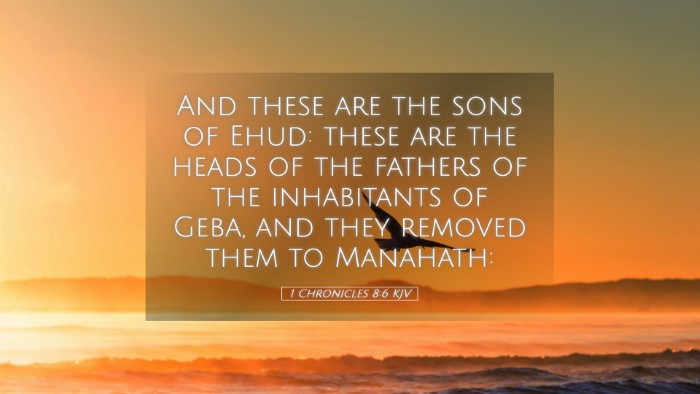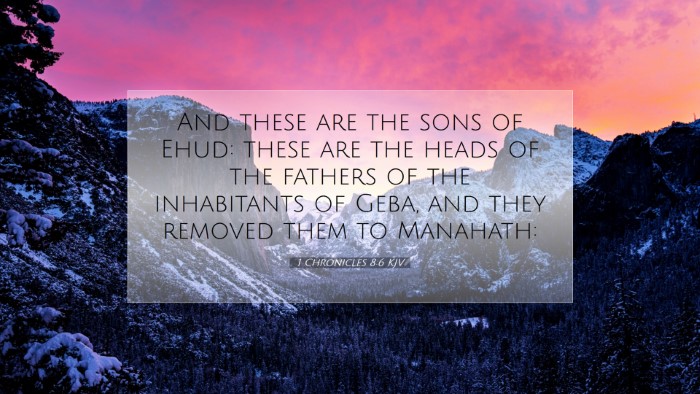Commentary on 1 Chronicles 8:6
Verse Context: 1 Chronicles 8:6 states, "These are the sons of Ehud: these are the heads of the fathers of the inhabitants of Geba, and they removed them to Manahath."
Introduction
The genealogies in 1 Chronicles serve a vital purpose in tracing the lineage of Israel, portraying the faithfulness of God through His promise to Abraham and his descendants. This particular verse highlights the descendants of Ehud and their significant move from Geba to Manahath, underlining not only their lineage but also pivotal events in the history of the Israelite tribes.
Insights from Matthew Henry
Genealogical Significance: Matthew Henry emphasizes the importance of genealogies in acknowledging the God's dealings with His people. This verse illustrates how the Lord's divine providence led the families of Ehud to relocate, a move that was both strategic and significant in the unfolding narrative of Israel's history.
Leadership and Heritage: Henry notes that Ehud was not only a judge but also a key figure whose lineage filled a leadership role among the Israelites. The mention of "heads of the fathers" conveys the structure within these families, highlighting their responsibility and influence in the community.
Insights from Albert Barnes
Historical Context: Albert Barnes places this verse in the broader historical context of Israel's settlement in the Promised Land. The move from Geba, a location already established, to Manahath can be understood to reflect a shift perhaps due to conflict, opportunity, or divine direction.
Military Implications: Barnes suggests that such moves were often strategic, indicating a need for relocation for defense or community building, which reflects the turbulent times the Israelites faced in establishing their presence in the regions surrounding them.
Insights from Adam Clarke
Exegesis of the Locations: Adam Clarke provides valuable insights into the geographical significance of Geba and Manahath. He remarks on the historical importance of these locations, pointing out how migration to Manahath marked a significant shift in the heritage and habitation of these tribes, emphasizing the role of geography in the narrative of Israel.
Cultural Implications: Clarke also touches on the cultural and social implications of such migrations, suggesting that movements like these contributed to the shaping of the Israelite identity, their alliances, and their communal cohesion.
Theological Reflection
The movement from one place to another serves as a metaphor for spiritual journeys in the life of believers today. Just as the descendants of Ehud experienced a relocation that reshaped their identity and roles within the community, Christians often find themselves in seasons of transition, called to new places where God can work through them.
- Divine Guidance: This passage illustrates God's ongoing guidance in the lives of His people, reminding us that He is in control of our paths.
- Heritage and Legacy: The emphasis on genealogy stresses the importance of legacy, encouraging believers to reflect on their spiritual heritage and commitments to future generations.
- Leadership Roles: The structure of familial leadership observed in this verse prompts a deeper consideration regarding our roles within the church and community.
Conclusion
1 Chronicles 8:6 is not merely a historical footnote but a rich narrative thread that illustrates essential themes of leadership, divine providence, and community. The emphasis on lineage speaks to the continuity of God's promises and challenges contemporary believers to recognize their own part within this ongoing story. Understanding these connections deepens theological comprehension and enriches biblical scholarship for pastors, students, and theologians alike.


